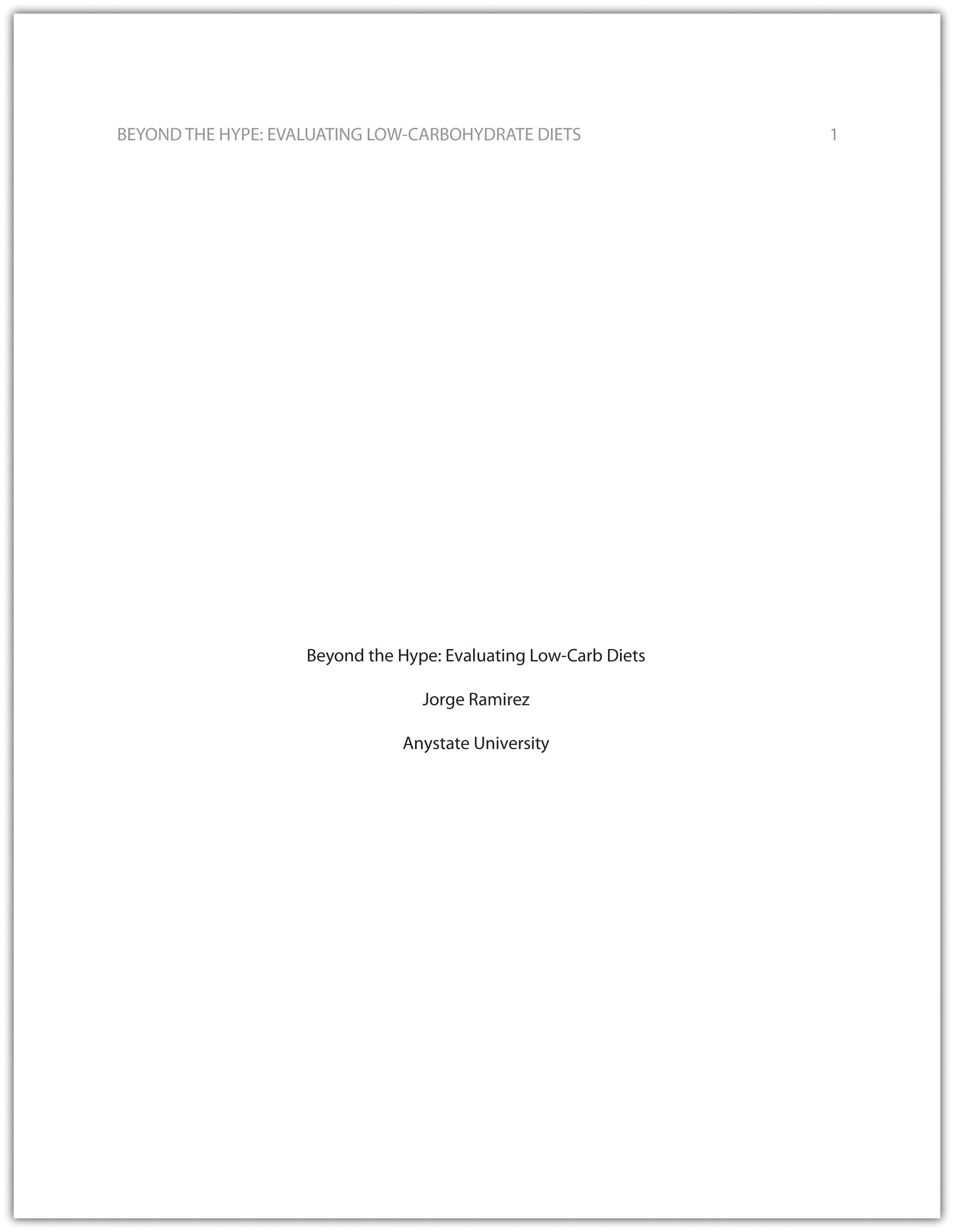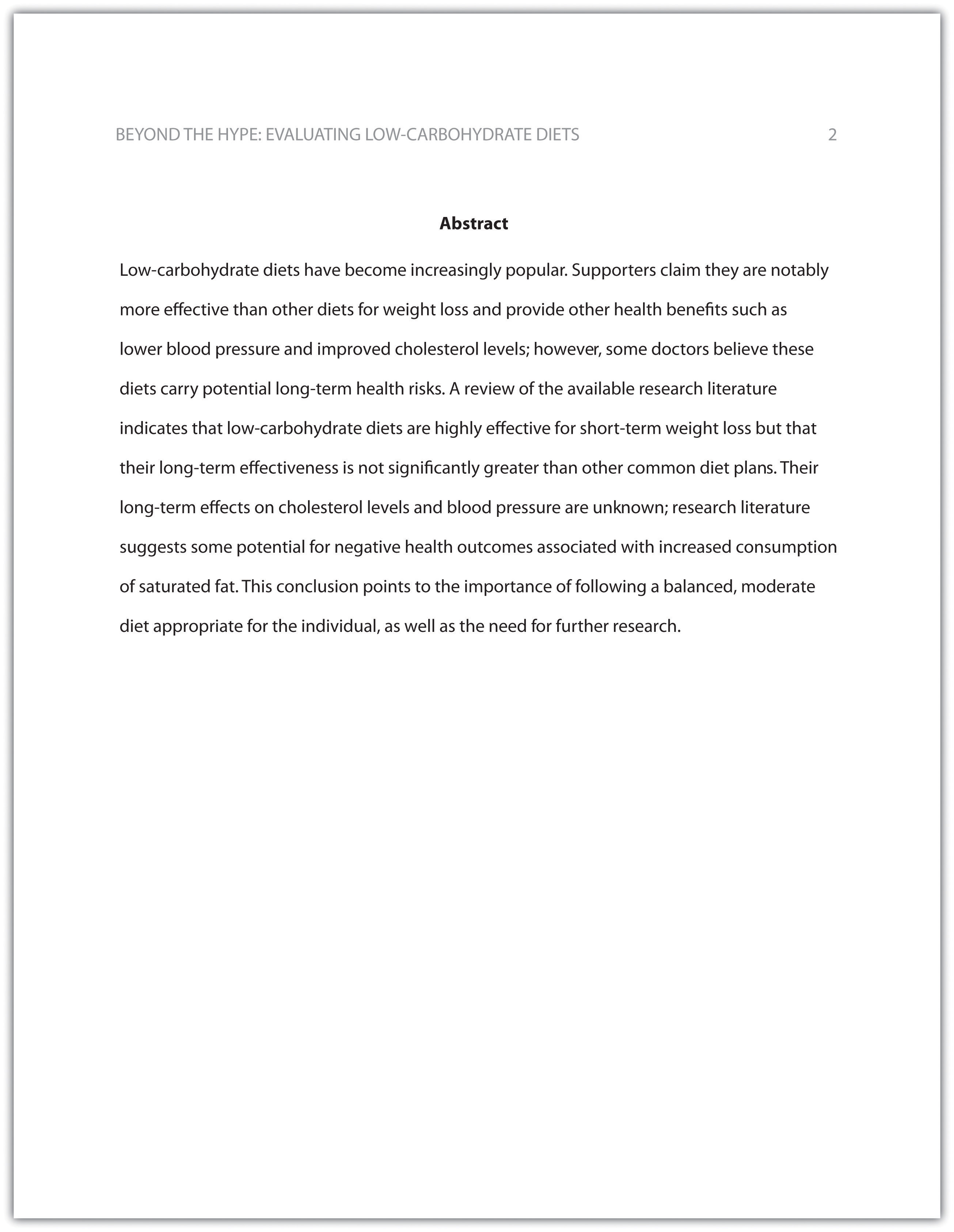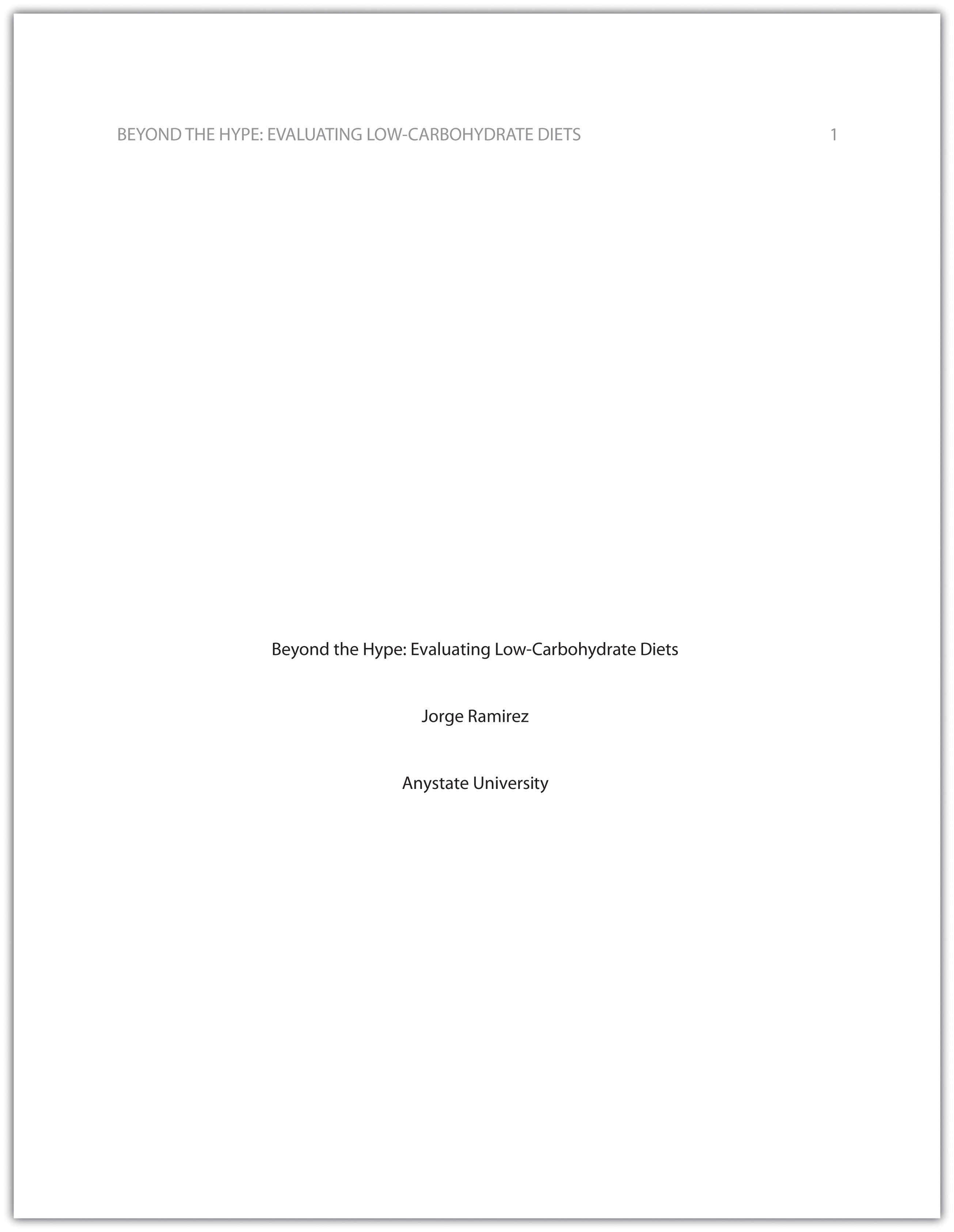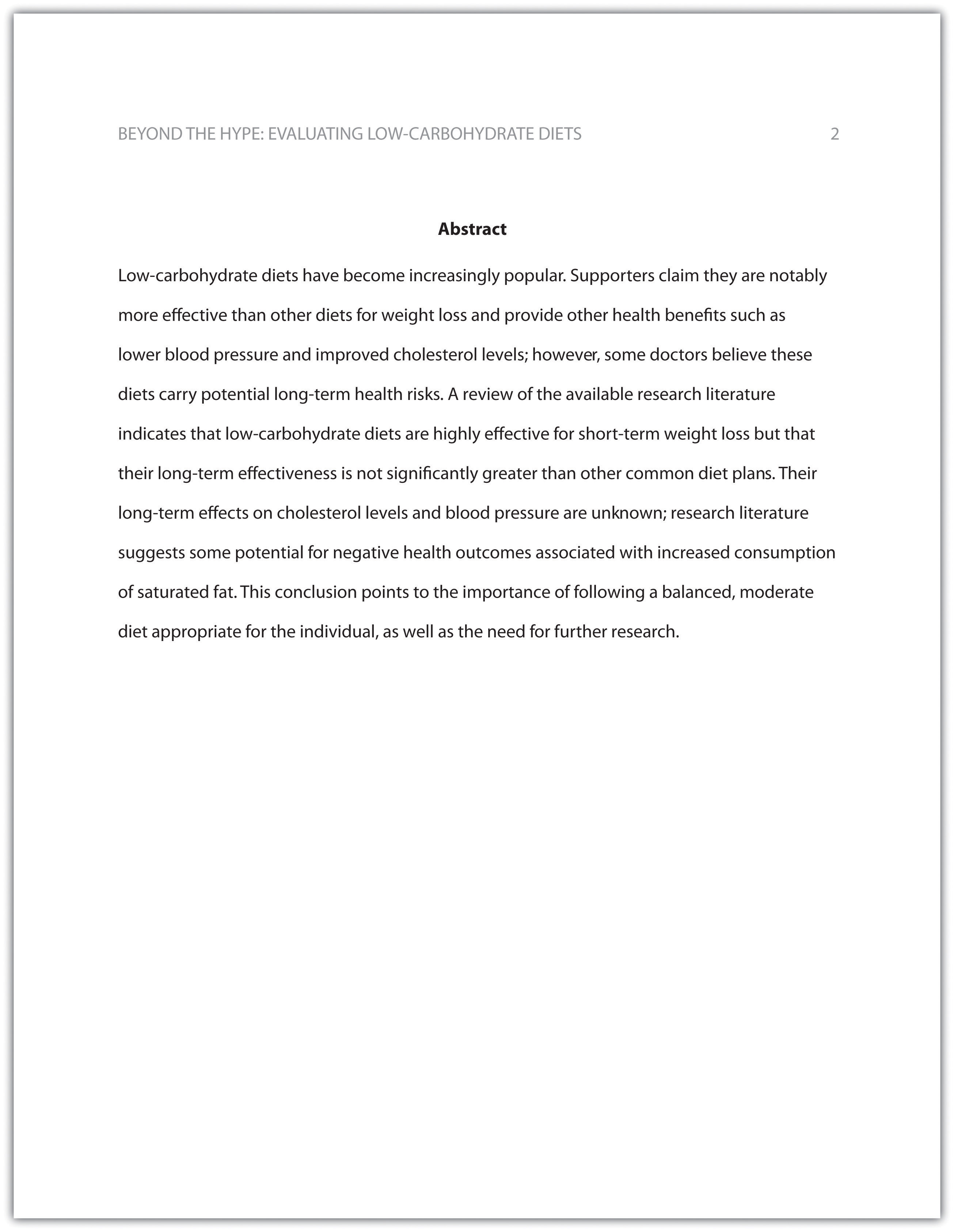Chapter 13 the Art of Structuring and Writing a Health Policy Analysis
13.1 Formatting a Inquiry Paper
Learning Objectives
- Identify the major components of a enquiry paper written using American Psychological Association (APA) style.
- Apply general APA style and formatting conventions in a enquiry paper.
In this chapter, you will learn how to use APA mode, the documentation and formatting fashion followed by the American Psychological Association, also as MLA style, from the Modern Linguistic communication Association. In that location are a few major formatting styles used in bookish texts, including AMA, Chicago, and Turabian:
- AMA (American Medical Association) for medicine, health, and biological sciences
- APA (American Psychological Association) for education, psychology, and the social sciences
- Chicago—a common style used in everyday publications similar magazines, newspapers, and books
- MLA (Modern Language Clan) for English, literature, arts, and humanities
- Turabian—some other common style designed for its universal application across all subjects and disciplines
While all the formatting and citation styles have their own utilise and applications, in this chapter we focus our attention on the 2 styles yous are most likely to use in your bookish studies: APA and MLA.
If you lot detect that the rules of proper source documentation are difficult to go on direct, you are not alone. Writing a good inquiry newspaper is, in and of itself, a major intellectual challenge. Having to follow detailed citation and formatting guidelines as well may seem like just one more task to add to an already-too-long listing of requirements.
Following these guidelines, however, serves several important purposes. Get-go, it signals to your readers that your paper should be taken seriously equally a student'south contribution to a given bookish or professional field; it is the literary equivalent of wearing a tailored suit to a chore interview. Second, it shows that you respect other people'due south work enough to give them proper credit for it. Finally, it helps your reader find boosted materials if he or she wishes to acquire more about your topic.
Furthermore, producing a alphabetic character-perfect APA-style paper demand not exist crushing. Aye, it requires careful attention to detail. However, you can simplify the process if you continue these broad guidelines in mind:
- Work alee whenever you lot can. Chapter 11 "Writing from Inquiry: What Volition I Learn?" includes tips for keeping track of your sources early in the research process, which will save time subsequently on.
- Get it right the first time. Apply APA guidelines every bit you write, and so you volition not have much to correct during the editing phase. Over again, putting in a little extra time early on can save time later.
- Use the resources available to yous. In addition to the guidelines provided in this chapter, you may wish to consult the APA website at http://world wide web.apa.org or the Purdue Academy Online Writing lab at http://owl.english.purdue.edu, which regularly updates its online style guidelines.
General Formatting Guidelines
This affiliate provides detailed guidelines for using the citation and formatting conventions developed by the American Psychological Association, or APA. Writers in disciplines as diverse as astrophysics, biology, psychology, and education follow APA style. The major components of a paper written in APA style are listed in the post-obit box.
These are the major components of an APA-way paper:
- Title page
- Abstract
-
Body, which includes the following:
- Headings and, if necessary, subheadings to organize the content
- In-text citations of research sources
- References folio
All these components must be saved in one document, non as separate documents.
Title Folio
The title page of your paper includes the following information:
- Title of the newspaper
- Author'due south proper name
- Name of the institution with which the author is affiliated
- Header at the acme of the page with the paper title (in capital letters) and the page number (If the title is lengthy, you lot may use a shortened form of information technology in the header.)
List the commencement three elements in the order given in the previous list, centered almost 1 third of the way downwards from the top of the folio. Use the headers and footers tool of your word-processing program to add the header, with the title text at the left and the folio number in the upper-right corner. Your title page should await similar the following example.

Abstract
The next page of your paper provides an abstract, or brief summary of your findings. An abstract does not demand to exist provided in every paper, but an abstract should exist used in papers that include a hypothesis. A good abstract is concise—about one hundred fifty to 2 hundred fifty words—and is written in an objective, impersonal style. Your writing voice will not be every bit apparent here every bit in the body of your paper. When writing the abstruse, take a but-the-facts approach, and summarize your research question and your findings in a few sentences.
In Chapter 12 "Writing a Research Newspaper", you read a newspaper written by a student named Jorge, who researched the effectiveness of depression-carbohydrate diets. Read Jorge's abstruse. Note how it sums up the major ideas in his paper without going into excessive particular.

Exercise 1
Write an abstract summarizing your paper. Briefly introduce the topic, land your findings, and sum up what conclusions you can draw from your enquiry. Utilize the word count feature of your give-and-take-processing program to brand sure your abstract does non exceed i hundred l words.
Tip
Depending on your field of study, you may sometimes write research papers that nowadays extensive principal research, such as your own experiment or survey. In your abstract, summarize your inquiry question and your findings, and briefly indicate how your study relates to prior research in the field.
Margins, Pagination, and Headings
APA style requirements too accost specific formatting concerns, such every bit margins, pagination, and heading styles, within the body of the newspaper. Review the post-obit APA guidelines.
Utilise these general guidelines to format the paper:
- Set the top, bottom, and side margins of your paper at 1 inch.
- Use double-spaced text throughout your newspaper.
- Use a standard font, such as Times New Roman or Arial, in a legible size (10- to 12-indicate).
- Employ continuous pagination throughout the paper, including the title page and the references department. Page numbers announced flush right within your header.
- Section headings and subsection headings inside the torso of your paper use dissimilar types of formatting depending on the level of data you are presenting. Additional details from Jorge's paper are provided.


Exercise 2
Begin formatting the last draft of your paper according to APA guidelines. You lot may work with an existing document or ready a new document if you cull. Include the following:
- Your title page
- The abstruse you created in Note 13.8 "Exercise one"
- Correct headers and page numbers for your championship page and abstract
Headings
APA style uses department headings to organize information, making it easy for the reader to follow the writer's train of idea and to know immediately what major topics are covered. Depending on the length and complexity of the paper, its major sections may likewise exist divided into subsections, sub-subsections, and so on. These smaller sections, in turn, apply dissimilar heading styles to indicate different levels of information. In essence, you are using headings to create a hierarchy of information.
The following heading styles used in APA formatting are listed in gild of greatest to least importance:
- Section headings use centered, boldface type. Headings apply championship instance, with important words in the heading capitalized.
- Subsection headings employ left-aligned, boldface type. Headings use title instance.
- The third level uses left-aligned, indented, boldface type. Headings use a upper-case letter letter but for the showtime word, and they end in a flow.
- The 4th level follows the same style used for the previous level, but the headings are boldfaced and italicized.
- The fifth level follows the aforementioned style used for the previous level, merely the headings are italicized and not boldfaced.
Visually, the bureaucracy of information is organized as indicated in Tabular array 13.1 "Section Headings".
Table 13.1 Section Headings
| Level of Information | Text Example |
|---|---|
| Level 1 | Eye Disease |
| Level 2 | Lifestyle Factors That Reduce Heart Disease Risk |
| Level 3 | Exercising regularly. |
| Level four | Aerobic exercise. |
| Level 5 | Country line dancing. |
A college research paper may not utilise all the heading levels shown in Table xiii.1 "Section Headings", only you are probable to run across them in academic journal articles that utilize APA fashion. For a brief paper, y'all may find that level i headings suffice. Longer or more than complex papers may need level 2 headings or other lower-level headings to organize information clearly. Use your outline to craft your major section headings and make up one's mind whether whatsoever subtopics are substantial enough to require boosted levels of headings.
Practise 3
Working with the document you developed in Note 13.eleven "Exercise 2", brainstorm setting up the heading construction of the last draft of your research paper according to APA guidelines. Include your title and at least ii to 3 major section headings, and follow the formatting guidelines provided in a higher place. If your major sections should be broken into subsections, add those headings as well. Utilise your outline to help y'all.
Because Jorge used only level 1 headings, his Exercise 3 would wait like the post-obit:
| Level of Information | Text Example |
|---|---|
| Level 1 | Purported Benefits of Low-Saccharide Diets |
| Level 1 | Research on Low-Carbohydrate Diets and Weight Loss |
| Level 1 | Other Long-Term Health Outcomes |
| Level one | Conclusion |
Citation Guidelines
In-Text Citations
Throughout the body of your newspaper, include a citation whenever you quote or paraphrase cloth from your inquiry sources. As you learned in Affiliate 11 "Writing from Inquiry: What Volition I Larn?", the purpose of citations is twofold: to give credit to others for their ideas and to let your reader to follow up and learn more about the topic if desired. Your in-text citations provide basic information virtually your source; each source y'all cite will have a longer entry in the references section that provides more detailed data.
In-text citations must provide the name of the writer or authors and the yr the source was published. (When a given source does not listing an individual author, yous may provide the source championship or the name of the organisation that published the textile instead.) When directly quoting a source, it is as well required that you include the folio number where the quote appears in your citation.
This information may be included within the sentence or in a parenthetical reference at the end of the sentence, as in these examples.
Epstein (2010) points out that "junk nutrient cannot exist considered addictive in the same fashion that we think of psychoactive drugs equally addictive" (p. 137).
Hither, the writer names the source writer when introducing the quote and provides the publication date in parentheses afterwards the author'due south name. The page number appears in parentheses after the closing quotation marks and before the menstruum that ends the judgement.
Habit researchers caution that "junk food cannot be considered addictive in the aforementioned way that we think of psychoactive drugs as addictive" (Epstein, 2010, p. 137).
Here, the writer provides a parenthetical citation at the end of the judgement that includes the writer's name, the year of publication, and the folio number separated past commas. Again, the parenthetical citation is placed later on the closing quotation marks and before the catamenia at the end of the sentence.
Equally noted in the volume Junk Nutrient, Junk Science (Epstein, 2010, p. 137), "junk food cannot be considered addictive in the same way that nosotros think of psychoactive drugs every bit addictive."
Here, the writer chose to mention the source title in the sentence (an optional piece of data to include) and followed the championship with a parenthetical citation. Notation that the parenthetical citation is placed before the comma that signals the end of the introductory phrase.
David Epstein'due south book Junk Food, Junk Scientific discipline (2010) pointed out that "junk food cannot be considered addictive in the same style that we call up of psychoactive drugs as addictive" (p. 137).
Another variation is to introduce the author and the source title in your sentence and include the publication date and folio number in parentheses within the sentence or at the end of the judgement. As long as you take included the essential information, you tin choose the option that works best for that particular sentence and source.
Citing a book with a single author is usually a straightforward task. Of course, your research may crave that you cite many other types of sources, such every bit books or manufactures with more than one writer or sources with no individual writer listed. You may likewise need to cite sources available in both print and online and nonprint sources, such every bit websites and personal interviews. Chapter 13 "APA and MLA Documentation and Formatting", Section 13.2 "Citing and Referencing Techniques" and Section thirteen.3 "Creating a References Section" provide extensive guidelines for citing a variety of source types.
Writing at Work
APA is just i of several different styles with its own guidelines for documentation, formatting, and language usage. Depending on your field of involvement, you may exist exposed to additional styles, such every bit the following:
- MLA style. Determined by the Modern Languages Association and used for papers in literature, languages, and other disciplines in the humanities.
- Chicago style. Outlined in the Chicago Transmission of Style and sometimes used for papers in the humanities and the sciences; many professional organizations use this fashion for publications every bit well.
- Associated Press (AP) style. Used by professional journalists.
References List
The brief citations included in the trunk of your paper stand for to the more detailed citations provided at the end of the paper in the references section. In-text citations provide basic information—the author's name, the publication date, and the folio number if necessary—while the references section provides more than extensive bibliographical information. Over again, this information allows your reader to follow upwardly on the sources y'all cited and practice additional reading nigh the topic if desired.
The specific format of entries in the list of references varies slightly for dissimilar source types, but the entries generally include the following information:
- The name(s) of the author(south) or institution that wrote the source
- The twelvemonth of publication and, where applicable, the exact date of publication
- The full championship of the source
- For books, the city of publication
- For manufactures or essays, the name of the journal or volume in which the article or essay appears
- For magazine and journal articles, the book number, issue number, and pages where the article appears
- For sources on the web, the URL where the source is located
The references folio is double spaced and lists entries in alphabetical order past the author's concluding proper noun. If an entry continues for more than one line, the second line and each subsequent line are indented five spaces. Review the following example. (Chapter 13 "APA and MLA Documentation and Formatting", Section 13.3 "Creating a References Section" provides all-encompassing guidelines for formatting reference entries for dissimilar types of sources.)
Tip
In APA mode, book and commodity titles are formatted in sentence instance, not title case. Sentence case means that simply the first word is capitalized, along with whatever proper nouns.
Fundamental Takeaways
- Following proper citation and formatting guidelines helps writers ensure that their work will be taken seriously, give proper credit to other authors for their work, and provide valuable information to readers.
- Working ahead and taking intendance to cite sources correctly the first fourth dimension are ways writers can save fourth dimension during the editing phase of writing a enquiry paper.
- APA papers usually include an abstract that concisely summarizes the newspaper.
- APA papers use a specific headings structure to provide a clear hierarchy of information.
- In APA papers, in-text citations unremarkably include the proper noun(south) of the author(s) and the yr of publication.
- In-text citations stand for to entries in the references section, which provide detailed bibliographical information nigh a source.
Source: https://open.lib.umn.edu/writingforsuccess/chapter/13-1-formatting-a-research-paper/
0 Response to "Chapter 13 the Art of Structuring and Writing a Health Policy Analysis"
Postar um comentário